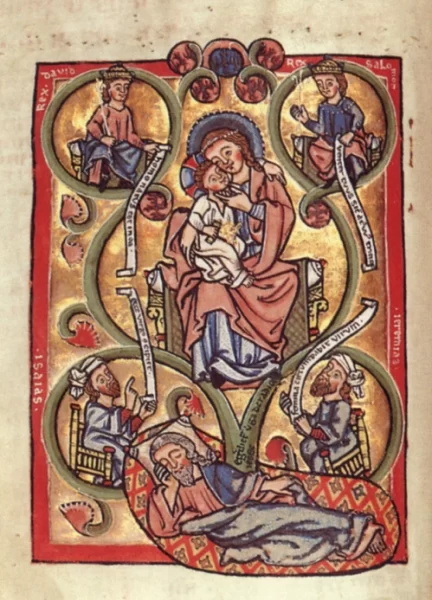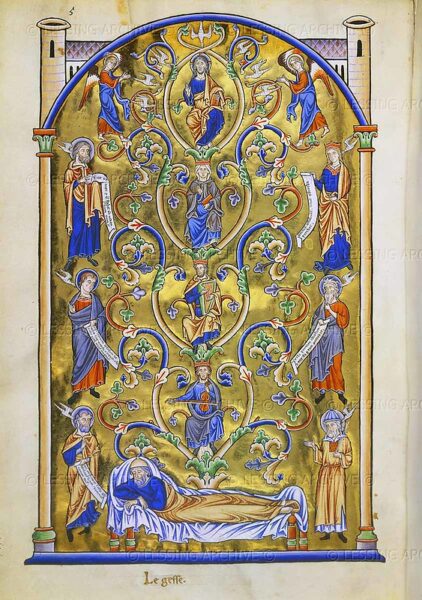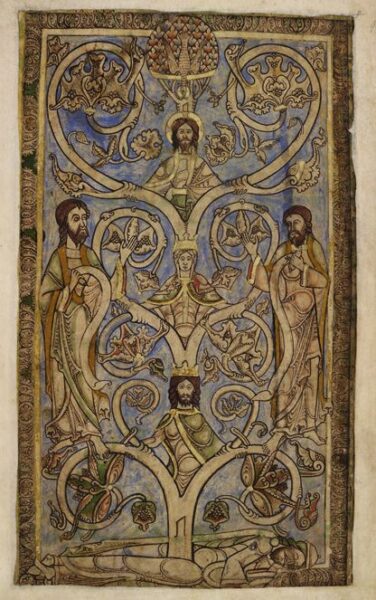 I wrote a blog post about the O Antiphons in 2019, and I loved picking out the image to illustrate each one. So I have decided to post on the O Antiphons again, in order to highlight additional images and to explore the scriptural roots of these meaningful word images. If you aren’t familiar with the O Antiphons or need a refresher, please check out my 2019 blog post here.
I wrote a blog post about the O Antiphons in 2019, and I loved picking out the image to illustrate each one. So I have decided to post on the O Antiphons again, in order to highlight additional images and to explore the scriptural roots of these meaningful word images. If you aren’t familiar with the O Antiphons or need a refresher, please check out my 2019 blog post here.
Today is the third O Antiphon out of the seven days before Christmas, in these late days of Advent intensification. As Christmas comes yet closer, it’s a good idea to bring our prayers closer to Christmas as well.
Recall that, even if you are still a little out of balance or are rushing around shopping or baking or wrapping or decorating for Christmas, reciting the words of the O Antiphon for each day takes less than a minute. You can easily include them before and after grace at dinner or as part of your advent wreath tradition. And if you take just another less than a minute to light a candle or your advent wreath beforehand, I promise the O Antiphons are breathtaking by candlelight!
You can find my blog post on the O Adonai antiphon from yesterday here and the blog post on the O Clavis David antiphon for tomorrow, here.
O Radix Jesse – Antiphon for December 19
O Radix Jesse, Root of Jesse, standing as a sign among the peoples, before you rulers will keep silence and to you the nations will make their prayer: come deliver us and delay no longer.
O Radix Jesse, qui stas in signum populorum, super quem continebunt reges os suum, quem gentes deprecabuntur: veni ad liberandum nos, jam noli tardare.
O Root of Jesse:
The most relevant source of this Messianic title of Root of Jesse can be found in the following passage from the book of Isaiah:
A shoot shall sprout from the stump of Jesse, and from his roots a bud shall blossom. The spirit of the Lord shall rest upon him: a spirit of wisdom and understanding, a spirit of counsel and of strength, a spirit of knowledge and of fear of the Lord. Not by appearance shall he judge, nor by hearsay shall he decide, and decide aright for the land’s afflicted. (Isaiah 11:1-4)
It was important to the gospel writers to establish Jesus as the rightful heir to the House of David. The Gospel of Matthew gives a detailed accounting of the lineage of Jesus, tracing his life back through a long list of ancestors to the root of Jesse. This genealogy “invites Christ’s ancestors to precede him at his advent, surround him at his coming, and join us in hearing and worshiping him. All the names pronounced in the genealogy together form the royal courtship of Wisdom.”
Note that it was prophesied that the Messiah was to be born with, and received, in a spirit of wisdom, understanding, counsel, strength, and knowledge. Within this mantle of wisdom, Christ was to appear like the first sprig of spring that sprouts from the stump of a tree that had been cut down. Here are two other verses from Isaiah that make reference to shoots and branches and one from Jeremiah that prefigures the coming of Jesus as a just shoot from the House of David:
On that day, the Branch of the Lord will be luster and glory, and the fruit of the earth will be honor and splendor for the survivors of Israel. (Isaiah 4:2)
He grew up like a sapling before him, like a shoot from the parched earth; There was in him no stately bearing to make us look at him nor appearance that would attract us to him. (Isaiah 53:2)
The days are coming, says the Lord, when I will fulfill the promise I made to the house of Israel and Judah. In those days, in that time, I will raise up for David a just shoot, who shall do what is right and just in the land. (Jeremiah 33:14-15)
From these passages, artists, especially between the 11th and 16th-centuries, frequently employed the artistic motif of the Jesse tree. The images shown in this blog post are from illuminated manuscripts from the 13th-century. Here, the iconography shows Jesse as the older man reclining at the base, out of whom the genealogy progresses. In the middle sections, we see various ancestors, depending on the artist, but they usually include David and Solomon. At the top, in the most prominent location, is Mary, together with Jesus, the Incarnate. However, there is some interesting ambiguity in the wording of the passage from Isaiah that might be intentional. A shoot (Jesus? Mary?) shall sprout from the stump of Jesse and from his roots (Jesus’ roots or Jesse’s roots?) a bud (Jesus?) shall blossom.
In connection with this ambiguity, here is a verse from Revelation that paradoxically names Jesus as both the Root and Offspring of David:
“It is I, Jesus, who have sent my angel to give you this testimony about the churches. I AM the Root and Offspring of David, the Morning Star shining bright.” The Spirit and the Bride say, “Come!” Let those who hear answer, “Come!” Let all who are thirsty come forward; let all who desire it accept the gift of life-giving water. (Revelation 22:16)
Thinking about roots and trees and branches makes me want to share with you this quote I found and that I may use in my book:
You know my roots well. You know how they were planted, how they grew, and how they were disseminated. These roots of mine took my heart and mind, and bound my soul with a chain of love. Jesus, Cultivator of Virtues, do not let the root planted in my heart dry out. Help it spread. The root is the heart’s intent. It is led by love to do good. If my root pleases you, Lord, make its branches sprout, so everyone can see my leaves, flowers, and fruit growing and praising your name.
(Umilta of Faenza 1226-1310)
This quote provides a deep dive into our rootedness in Christ. It calls on us to bind together our hearts and minds, so that the roots of our lives can grow from the tending God gives us. Roots provide stability of connection. Roots also provide us with the living water we need to persevere in faith. Jesus had a family tree in which he was equally deeply rooted. In fact, Paul links the prophesies of Isaiah explicitly to Christ, in the following verses from his letter to the Romans:
Once more, Isaiah says, “The root of Jesse will appear, he who will rise up to rule the Gentiles; in him the Gentiles will find hope.” So may God, the source of hope, fill you with all joy and peace in believing so that, through the power of the Holy Spirit, you may have hope in abundance. (Romans 15:12-13)
Here, Paul writes the Good News that, in our rootedness in Jesus, we may receive what we all long for: joy, peace, and hope in abundance.
Standing as a sign among the people. Before you, rulers will keep silence and to you the nations will make their prayer:
So shall [the coming messiah] startle many nations. Because of him, rulers shall stand speechless. For those who have not been told, shall see, and those who have not heard, shall ponder it. (Isaiah 52:15)
What does it mean to stand as a sign to the people with such presence and integrity that rulers keep silent? What came to mind first for me was the presence that Jesus exhibited when he stood before Pilate, and the second thing that came to mind is the following verse from Proverbs:
Wisdom cries aloud in the street – in the open squares, she raises her voice. She cries out from the top of walls and delivers her message on the roads leading into the city. (Proverbs 1:20-21)
Wisdom stands on the walls at the gates of the cities as a sign among the people, crying out for justice. My understanding is that in the Old Testament, the city gates that guard the roads leading into town were places where signs were placed and business was conducted.
But how much wisdom and spiritual acumen are required, in order to have enough presence to advocate for justice, in such a way that others stand speechless? Clearly we are called to work for justice, but we certainly can’t accomplish this degree of integrity on our own. However, maybe in our advent-waiting for the birth of Jesus/Wisdom, we can take some time to reflect and to pray/listen for the strength and wisdom to improve our work for justice.
Speaking of roots, in this excerpt from Sirach, we see a reference to the root of wisdom:
Wisdom comes from Our God; She dwells with God forever. Who can count the sand in the sea, the drops of rain, the days of eternity, the height of the sky, the width of the earth, the depth of the abyss? Only Wisdom can – the first of all creation; judicious understanding from the beginning. To whom has the root of wisdom been disclosed? Who understands Her resilience? There is only One, wise and awe-inspiring; One who sits upon the judgement seat. It is Our God who created Her; espied Her; appraised Her; who has poured Her forth upon all God’s works, upon every living creature, as a gift, and lavished Her upon those who love the Most High. (Sirach 1:1-8)
I like the way that roots and wisdom are intertwined in this reading. The O Wisdom antiphon two evenings ago has been woven into the O Adonai antiphon (Wisdom-Jesus in the burning bush) and again today in the O Root of Jesse antiphon. She is the undercurrent who ties all of these rich O Antiphon images together. How do you trace the roots of wisdom and being rooted in Christ in your life? What acts of justice require your presence and the strength of your convictions this season?
Come deliver us and delay no longer.
Come and deliver us – delay no longer. This is pretty straightforward. This is the third night of the O Antiphons – the third time we ask Jesus to come to save us. This impatient call for deliverance is increased by the addition of the words “and delay no longer.” Now, only 6 days away from Christmas, with increasing anticipation, we again implore Jesus to come quickly and without delay!
As a reminder, there are a couple of options if you are interested in hearing the O Antiphons chanted in Latin. First, if you click here you will go to the Traditional Catholic Living website (Reference 8) that has a link to each O Antiphon, with the words and music so that you can follow and chant along. You can also find the chants here at an LDS blog post (Reference 9.) I like this link, because it includes the entire vespers sequence. Each O Antiphon is chanted, followed by the Magnificat, finishing with the O Antiphon chanted again.
In my opinion, listening to the Gregorian chanting by candlelight is the best way to experience the O Antiphons!
Readings: The New American Bible, Confraternity of Christian Doctrine, Washington DC, 1970.
Reference 1: Victoria Emily Jones, “Jesus as the Root/Shoot/Branch of Jesse,” blog post at The Jesus Question website, December 18, 2015.
Reference 2: Aboreal Krapo, “The Tree of Jesse,” blog post at the Aboreal Krapo website, May 14, 2008.
Reference 3: Malcolm Guite, “O Radix, A Third Advent Reflection and Sonnet,” blog post, December 19, 2021.
Reference 4: Ives Digory, O Radix Jesse: Meditations on the O Antiphons, blog post at Sanctum in Heremis website, December 19, 2014.
Reference 5: O Root of Jesse, Mount Saint Mary’s Cistercian Abbey, Wrentham MA, December 19, 2018.
Reference 6: Br. Jerome OSB, “Reflections on the O Antiphons,” blog post at https://liturgy.co.nz/reflection/oantr2.html, 2011.
Reference 7: Iconreader, “Root of Jesse Icon: Christ’s Family Tree,” blog post at A Reader’s Guide to Orthodox Icons website, December 23, 2011.
Reference 8: Sing the O Antiphons Gregorian Chant, Traditional Catholic Living website, http://www.traditionalcatholicliving.com/o-antiphons-advent/.
Reference 9: Awaiting the Coming Messiah: The “O Antiphons,” LDS Seasonal Materials, http://huntsmanseasonal.blogspot.com/2013/12/awaiting-coming-messiah-o-anitiphons.html.
Image 1: Tree of Jesse with the Madonna and Child (Cod. St. Peter perg. 139, Blatt 7v), from the Scherenberg Psalter, ca. 1260. Held at the Badische Landesbibliothek (Baden State Library), Karlsruhe, Germany.
Image 2: Tree of Jesse, from the Psautier d’Ingeburge, circa 1210-1218, Conde Museum, Chantilly, France, Chantilly, Musée Condé
MS 94695, fol. 14v.
Image 3: The Tree of Jesse, from the Winchester Psalter, folio 9r, possibly made for Henry of Blois in Winchester England, circa 1150 – 1275, Cotton MS Nero C IV, British Library.

















Leave a Reply
Join the conversation by submitting a comment to this blog post below.